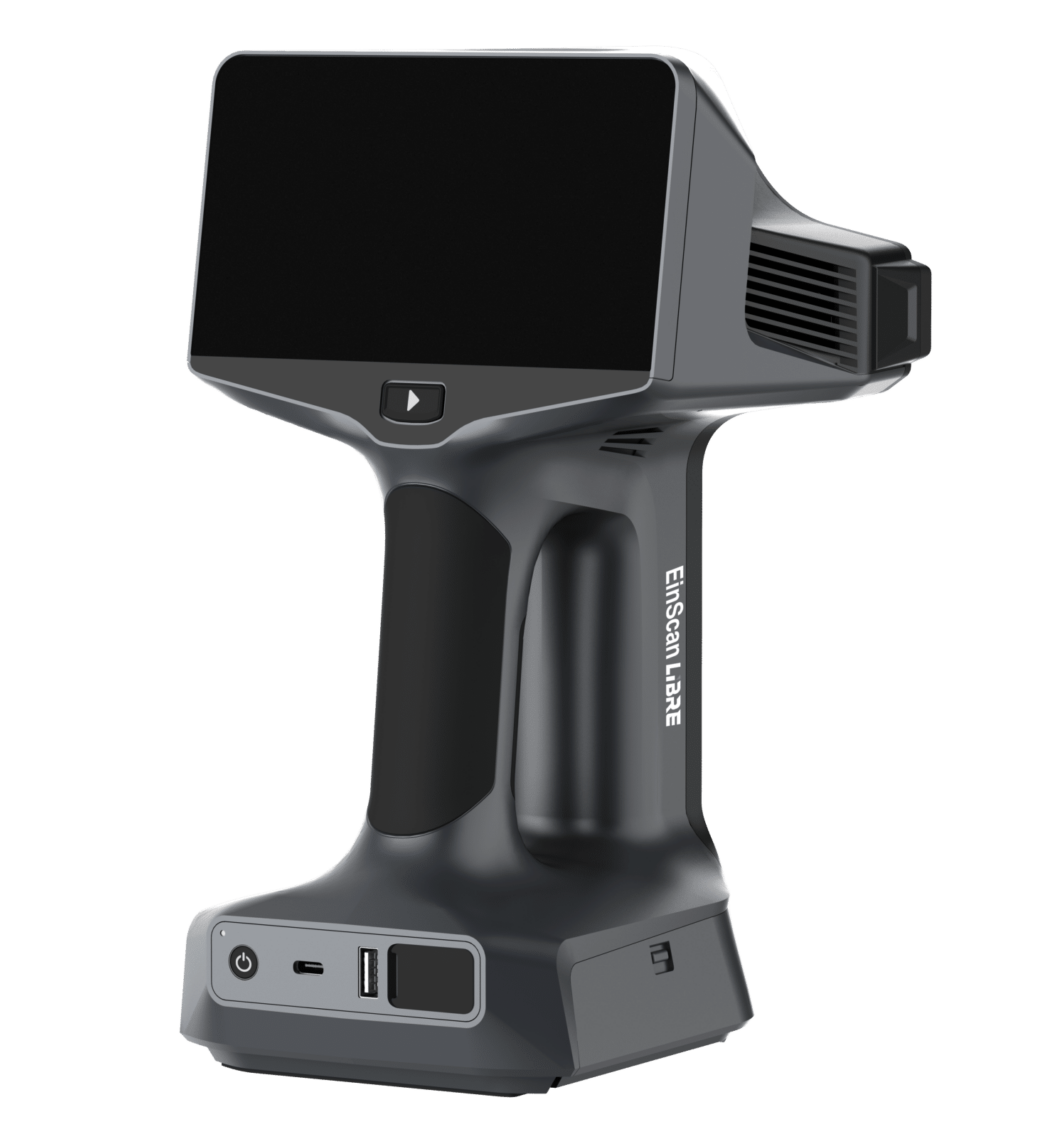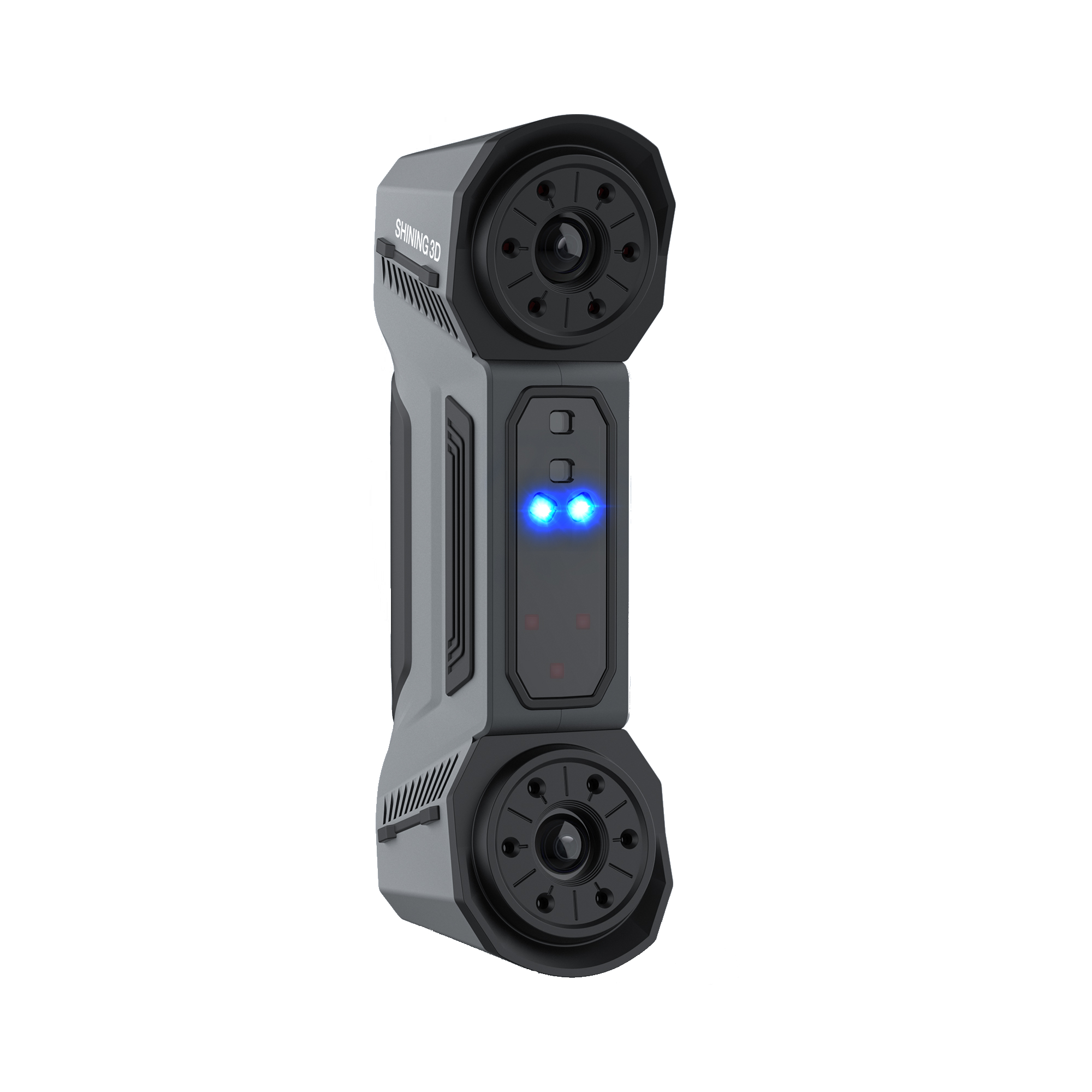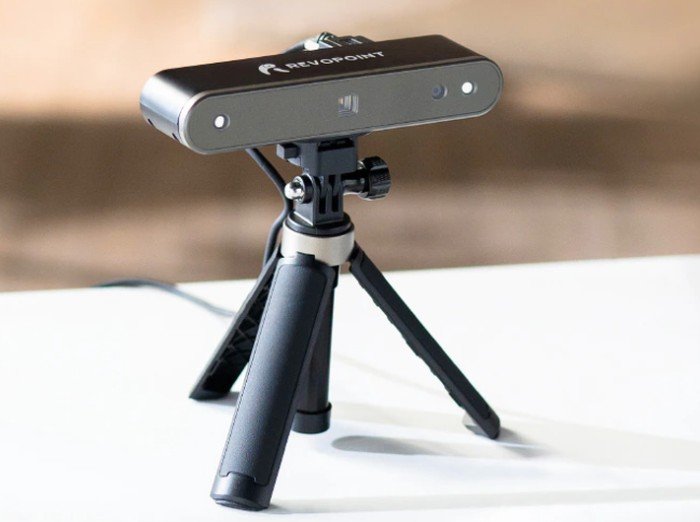The best 3D scanners in 2024 for every application

What is the best 3D scanner?
Many different types of 3D scanners exist, from desktop 3D scanners to handheld 3D scanners and advanced metrology systems. 3D scanners serve an extremely wide range of applications, from reverse engineering to 3D body scanning or even forensic investigations.
However, given the low number of reliable 3D scanner reviews, it can be challenging to find the best 3D scanner. It can also be complex to know what kind of 3D scanner to get based on your application. A $2,000 3D scanner won’t be sufficient for part inspection, and a $60,000 3D scanner would be overkill if you don’t need the precision.
With that in mind, our goal is to offer an overview of the best 3D scanners in different categories. We broke down our best 3D scanner picks into actionable selections:
- Professional: A mix of the best desktop and handheld options for professionals
- Affordable: Entry-level 3D scanners for makers with prices starting at around $400
- Metrology: High-precision 3D scanners for demanding use cases
- Handheld: Portative devices that can access hard-to-reach places
- SLAM and iMMS: Mobile laser 3D scanners for BIM and other large-scale applications
- TLS: Terrestrial LiDAR scanners
- Dental (desktop): Stationary 3D scanners for the dental labs
- Jewelry: Closed, high-precision 3D scanners for jewelers
- 3D body scanners: Booths and handheld color 3D scanners
Note that there can be some overlap between categories. For example, some handheld 3D scanners are precise enough for metrology or can capture colors and work for 3D body scanning.
Tip: Use the table of contents to the top left of your screen to easily navigate between our selections.
We also run through different 3D scanning applications (reverse engineering, 3D inspection, architecture, etc.) and provide concise explanations of the various 3D scanning technologies that exist.
Professional 3D scanner selection
This category groups some of the best professional 3D scanners. Our selection spans a wide price spectrum and includes both desktop scanners and handheld 3D scanners. These 3D scanners can cover most professional use cases.
| Brand | Product | Accuracy | Country | Price
Approximate starting prices based on supplier-provided information and public data. Prices may vary by region, over time and do not include additional products or services (taxes, shipping, accessories, training, installation, …).
| |
|---|---|---|---|---|---|
| SCANTECH (HANGZHOU)
Product data validated by the manufacturer.
| SIMSCAN-E | 0.02 mm | China | upon request | Quote |
| SCANTECH (HANGZHOU)
Product data validated by the manufacturer.
| KSCAN-Magic | 0.02 mm | China | upon request | Quote |
| Shining 3D
Product data validated by the manufacturer.
| EinScan Libre | 0.04 mm | China | upon request | Quote |
| Shining 3D
Product data validated by the manufacturer.
| FreeScan Combo+ | 0.02 mm | China | upon request | Quote |
The products in the table are ranked by price (low to high).

| Brand | Product | Technology | Category | Country | Price
Approximate starting prices based on supplier-provided information and public data. Prices may vary by region, over time and do not include additional products or services (taxes, shipping, accessories, training, installation, …).
| |
|---|---|---|---|---|---|---|
| SCANTECH (HANGZHOU)
Product data validated by the manufacturer.
| SIMSCAN-E | Laser triangulation | Handheld | China | upon request | Get a quote |
| SCANTECH (HANGZHOU)
Product data validated by the manufacturer.
| KSCAN-Magic | Laser triangulation | Handheld | China | upon request | Get a quote |
| Shining 3D
Product data validated by the manufacturer.
| EinScan Libre | Laser triangulation | Handheld | China | upon request | Get a quote |
| Shining 3D
Product data validated by the manufacturer.
| FreeScan Combo+ | Hybrid | Handheld | China | upon request | Get a quote |
Overview of the best professional 3D scanners
| Country | China |
| Category | Handheld |
| Technology | Laser triangulation |
| Max resolution | 0.02 mm |
| Price | upon request |
The SIMSCAN-E is an intelligent, wireless, and palm-sized 3D scanner that combines a lightweight design with exceptional performance. Featuring advanced edge computing and wireless data transfer, it sets a new standard for flexible, wireless and free 3D scanning.
With robust algorithm and high-definition industrial cameras, SIMSCAN-E can capture 3D data with remarkable precision and efficiency, measuring up to 6.3 million points /s. It boasts three scanning modes, ultra-fast, hyperfine, and deep hole. This versatility allows it to handle a wide range of tasks effortlessly, from scanning in tight spaces to measuring complex structures.
| Country | China |
| Category | Handheld |
| Technology | Laser triangulation |
| Max resolution | 0.01 mm |
| Price | upon request |
KSCAN-Magic is lightweight and portable and can conduct 3D measurements anywhere and anytime regardless of vibrations, temperature, and humidity. Moreover, KSCAN-Magic is capable of 3D scanning various surfaces to capture precise 3D data, and it performs well even in 3D scanning reflective and black surfaces.
The KSCAN handheld 3D scanner boasts an exceptional scanning accuracy of up to 0.020 mm. When coupled with the MSCAN-L15 photogrammetry system, it excels even further by achieving a volumetric accuracy of 0.015 mm + 0.012 mm/m. This technology is pivotal in driving ultra-high precision Non-destructive Testing (NDT) catering to a diverse range of industries.
| Country | China |
| Category | Handheld |
| Technology | Laser triangulation |
| Max resolution | 0.05 mm |
| Price | upon request |
Experience the perfect blend of freedom and accuracy with the EinScan Libre. This advanced wireless scanner delivers an impressive volumetric accuracy of up to 0.04 + 0.06 mm/m, ensuring that every detail is captured with pinpoint precision. Whether working on intricate designs or complex projects, the EinScan Libre provides the reliability and accuracy you need, all in a truly wireless device.
Equipped with both laser and infrared light, the device adapts to a wide range of materials and excels at capturing detailed textures. Its Laser HD mode supports texture alignment during scanning, improving accuracy on complex surfaces. The EinScan Libre is the first standalone 3D scanner on the market to support texture alignment.
| Country | China |
| Category | Handheld |
| Technology | Hybrid |
| Max resolution | 0.05 mm |
| Price | upon request |
Scanners from the powerful FreeScan Combo Series pack dual light sources in an ultra-compact shell, measuring just 193 x 63 x 53mm.
They’re equipped with both blue laser and infrared VCSEL technology and weigh in at only 620g.
This lightweight, handheld 3D scanner offers four modes: multiple-line scanning, single-line scanning, fine scanning, and infrared scanning.
Its multiple-line mode projects up to 50 laser lines (FreeScan Combo + version) and scan at speeds of up to 3,600,000 points/sec.
The FreeScan Combo Series’ efficiency, combined with its hybrid technology, wide FOV, and material adaptability, make it highly versatile.
From inspection, reverse engineering, and product design to additive manufacturing and other demanding applications, the FreeScan Combo and Combo + can easily handle a wide range of use cases.
Affordable 3D scanners for makers
This selection includes some of the best affordable 3D scanners for makers.
| Brand | Product | Accuracy | Country | Price
Approximate starting prices based on supplier-provided information and public data. Prices may vary by region, over time and do not include additional products or services (taxes, shipping, accessories, training, installation, …).
| |
|---|---|---|---|---|---|
| Creality
Product data validated by the manufacturer.
| CR-Scan Ferret Pro | 0.1 mm | China | $ 429 | Quote |
| 3DMakerpro
Product data validated by the manufacturer.
| 3D Scanner Mole | 0.05 mm | China | $ 649 | Quote |
| Revopoint | POP 2 | 0.1 mm | China | $ 699 | Quote |
| Shining 3D
Product data validated by the manufacturer.
| EINSTAR VEGA | – | China | $ 1,999 | Quote |
The products in the table are ranked by price (low to high).

| Brand | Product | Technology | Country | Price
Approximate starting prices based on supplier-provided information and public data. Prices may vary by region, over time and do not include additional products or services (taxes, shipping, accessories, training, installation, …).
| |
|---|---|---|---|---|---|
| Creality
Product data validated by the manufacturer.
| CR-Scan Ferret Pro | Structured light | China | $ 429 | Get a quote |
| 3DMakerpro
Product data validated by the manufacturer.
| 3D Scanner Mole | Structured light | China | $ 649 | Get a quote |
| Revopoint | POP 2 | Structured light | China | $ 699 | Get a quote |
| Shining 3D
Product data validated by the manufacturer.
| EINSTAR VEGA | Structured light | China | $ 1,999 | Get a quote |
Overview of the best affordable 3D scanner options
| Country | China |
| Category | Handheld |
| Technology | Structured light |
| Price | $ 429 |
Creality CR-Scan Ferret Pro overview
The CR-Scan Ferret Pro is a affordable 3D scanner produced by Creality, a manufacturer based in China.
The CR-Scan Ferret Pro Creality uses the structured light technology.
| Country | China |
| Category | Handheld |
| Technology | Structured light |
| Price | $ 649 |
3DMakerpro 3D Scanner Mole overview
The 3D Scanner Mole is a affordable 3D scanner produced by 3DMakerpro, a manufacturer based in China.
The 3D Scanner Mole 3DMakerpro uses the structured light technology.
| Country | China |
| Category | Desktop |
| Technology | Structured light |
| Price | $ 699 |
Revopoint POP 2 overview
The POP 2 is a affordable 3D scanner produced by Revopoint, a manufacturer based in China.
The POP 2 Revopoint uses the structured light technology.
| Country | China |
| Category | Handheld |
| Technology | Structured light |
| Price | $ 1,999 |
The EINSTAR Vega is a powerful 3D scanner that combines two scanning technologies in one device and can be operated anywhere, mobile and without a computer.
Metrology 3D scanner selection
3D metrology is the process of acquiring highly accurate physical 3D measurements of an object. The result is a digital 3D model that users can analyze or retro-engineer.
Take quality inspection, for example. Professionals can compare the 3D scan to a reference CAD model to make sure the object respects established norms and standards. 3D metrology helps ensure product quality while saving time and, thus, lowering costs.
Read on:
The best metrology 3D scanners
Handheld 3D scanner selection
Handheld 3D scanners have been gaining a lot of popularity over the past few years. They offer various benefits over other types of 3D scanners:
- Ability to access hard-to-reach places
- Relative ease of use
- Portability
Their versatility makes them suitable for a wide range of industries, including automobile, aerospace, engineering, and design, and some can even be used for 3D body scanning.
SLAM 3D scanner selection
SLAM (Simultaneous Localization and Mapping) technology allows a device to position itself and navigate through a given space based on its surroundings. Sometimes called CML (Concurrent Mapping and Localization), it was initially developed for robots and autonomous appliances.
In 3D scanning (mobile mapping), SLAM algorithms combine and use the sets of data collected from one or more sources to track the scanner’s position, all while building up an accurate, complete 3D point cloud of the surrounding environment.
SLAM-based 3D scanners can work in extremely remote locations where GPS or GNSS signals are unavailable, and make it easy to quickly 3D scan large areas like building sites and underground caves.
TLS (Terrestrial Laser Scanner) selection
Terrestrial laser scanning (TLS) is a form of 3D scanning in which tripod-mounted laser scanners are used to capture large objects and environments. The technique is widely used in construction, surveying, forestry, and other disciplines.
Also known as long-range laser scanning, TLS involves deploying a scanner in a static location, whereas other laser scanners may be handheld or mounted to vehicles to capture data from a greater number of vantage points. TLS produces more accurate scans than mobile scanning — at the expense of speed and simplicity.
These 3D scanners are often generically called LiDAR scanners, though terrestrial scanners aren’t the only type of scanner to use the technology.
Desktop dental 3D scanner selection
Bit by bit, dentists are beginning to replace traditional methods with digital dentistry. This involves the use of digital capture, digital design, and digital production technologies to improve the speed, accuracy, and profitability of dental practice.
A key part of digital dentistry is the use of 3D scanners, which capture 3D shapes using a combination of cameras and light projection before transferring the result to a computer.
Desktop dental 3D scanners capture dental models or impressions (negative imprints of a patient’s teeth and gums) and are usually used in a laboratory setting.
Jewelry 3D scanner selection
A popular use of 3D scanning technology is jewelry 3D scanning. This is the process of 3D scanning jewelry, precious metals, and gemstones with the goal of creating a digital copy of the original object. The digital twin can be used for many purposes, such as repairing or duplicating a valuable item.
3D scanners have been adopted as a supplementary tool by traditional jewelers, but the technology has also allowed newcomers to enter the field, many of which have combined 3D scanning with jewelry 3D printing.
Most jewelry 3D scanners are enclosed or partly enclosed desktop machines that offer ideal lighting conditions. Desktop jewelry 3D scanners almost always feature an automatic turntable, or auto-rotating table, on which the piece of jewelry is placed to be scanned.
3D body scanner selection
3D body scanners are designed to capture your full body in 3D. The result is a 3D model (or 3D avatar) of your exact body shape with accurate data such as body measurements, posture analysis, textures, …
Originally developed for the fashion industry as fast and accurate 3D measurement solutions, 3D body scanners are now used in various other fields such as healthcare, 3D figurines and 3D photos, fitness, and entertainment.
To obtain a full-body 3D scan, the customer or patient holds a pose for a few seconds, which is the time it takes for the 3D scanner to capture images from all angles. The 3D software then reconstructs the final 3D model of the body by “stitching” all of the images together, generating a highly detailed 3D model. Models can have colors and textures depending on the type of body scanner.
Read on:
The 6 best 3D body scanners in 2024
Which 3D scanner is the best for me?
3D scanning can be used in a large variety of fields. For every application, the features necessary to generate a great 3D model are different. The 3D scanner must be chosen according to your desired use and results.
What the best 3D scanner is for you will depend on many factors, detailed below.
3D scanning field of application
The first thing to take into consideration is the field in which the 3D scanner will be used. It could be for example:
Professional use
- Small objects: dentists, jewelers, and other professionals can use 3D scanning to capture small pieces.
- Big objects: professionals such as architects and archeologists might need to 3D scan large objects such as statues, archeological fields, or buildings.
- 3D body scanning is increasingly used in various professional fields such as healthcare and 3D figurines.
Personal use
- Occasional scanning: A person might need to use 3D scanning on rare occasions or maybe just one time.
- 3D scanning on a regular basis: You can use 3D scanning for various things from making personalized objects to making a replica of yourself, friends, or family members.
Type of 3D scanned object
Dimensions and distance of the object (scan area and scanning range)
The “best 3D scanner” will depend on the dimensions and the distance of the objects you wish to 3D scan. A desktop 3D scanner can’t 3D scan a 2-meter-tall statue, and a handheld 3D scanner might not be the best option to 3D scan a very small and precise piece.
Surface of the object
Not every 3D scanner is able to capture colors. For color capture, you need a scanner with photogrammetry.
It can also be challenging to capture objects with black, shiny, or reflective surfaces. However, as 3D scanning OEMs fine-tune their technology and hardware, such surfaces are becoming less and less of a challenge. For cases where it is a challenge, it is always possible to use a white mattifying spray.
Desired resolution
Not all 3D scanners offer the same level of resolution. Therefore, depending on the quality you need, some 3D scanner models are more adapted than others. Reverse engineering requires high resolution and precision, for example.
3D scanner recommendations
Desktop 3D scanners
Desktop 3D scanners can be ideal for both professionals and hobbyists that need to scan small parts. They tend to be more accurate since you aren’t holding and moving the 3D scanner around yourself.
Also, many desktop 3D scanners come with (or at least optionally) an automatic turntable, which makes it much easier to get clean 3D scans.
Handheld 3D scanners
Handheld 3D scanners, a.k.a. portable 3D scanners, are versatile and can 3D scan small to very large objects. They also enable users to 3D scan hard-to-reach places. The precision and the ability to capture color and texture will depend on the 3D scanner model.
3D body scanners
3D body scanners have applications in numerous fields.
- Professionals: professionals might want to 3D scan a person to make a 3D figurine, prepare for a surgical intervention, follow-up on a pregnancy or skin conditions, etc.
- Individuals: 3D body scanners can help with fitness goals and personal shape. These 3D scanners usually can’t capture color and texture but offer a high resolution.
3D scanning mobile apps
3D scanning mobile apps are ideal for occasional users that are not willing to or are unable to invest in a 3D scanner. They are not as precise as most 3D scanners, but mobile apps are a great way to get familiar with 3D scanning.
More on 3D scanning apps:
The best 3D scanning apps for smartphones in 2024
3D scanner price
3D scanner prices can range from just several hundred dollars to over $100,000.
Desktop 3D scanner price
Desktop 3D scanner prices vary a lot from one model to another. It can start at a few hundred dollars and can top out at around $50,000 for the more advanced 3D scanners. More industrial-grade, robot-mountable scanners can cost double.
Handheld 3D scanner price
The handheld 3D scanner price range is very wide. A professional handheld 3D scanner can start at around $5,000 and can reach up to over $70,000 for very high-end and advanced 3D scanners.
There are plenty of great entry-level options for a couple of thousand dollars. Mid-range handheld 3D scanners tend to cost between $10,000 and $30,000.
Industrial 3D scanner price
Industrial 3D scanners generally offer more cutting-edge features and higher precision. Hence, their prices can be pretty high, ranging from $10,000 for the simplest ones to more than $100,000 for the most evolved ones.
3D scanning applications
There are many reasons to buy a 3D scanner, for various industries and applications.
Reverse engineering
Reverse engineering, also known as retro-engineering, is the process of extracting information from an object or process and studying it. 3D scanners can be used to capture all the parts of a disassembled object to create a 3D model. The user will then be able to digitally study it in 3D afterward.
More on 3D scanning and reverse engineering:
What is reverse engineering?
Jewelry
Jewelers are starting to use 3D printing and 3D scanning to build casts in order to create amazing jewels. Read more on our 3D printing and 3D scanning for jewelry page.
Dental
Dentists and dental labs are using 3D printing to build and create various dental appliances. Find more information on our 3D printing and 3D scanning for the dental industry.
Medical
3D scanners are very versatile and are used in many different ways in healthcare, from making prosthetics to studying a person’s posture. Find more information in our guide to 3D scanning and 3D printing for the medical industry.
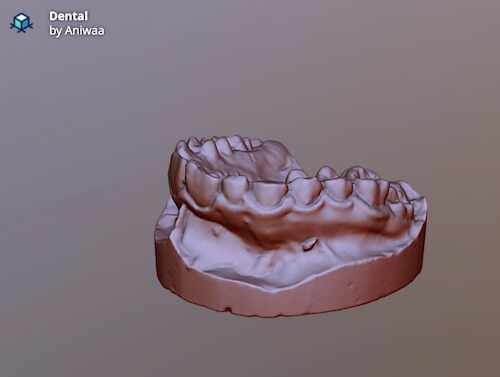
Metrology/inspection
Industries need to make sure their factories are producing perfect products that are perfectly in line with the products’ reference dimensions. 3D scanners enable professionals to efficiently measure potential discrepancies.
More on part inspection:
An overview of 3D scanning for part inspection
Figurines and 3D selfies
3D portraits or mini-me’s are increasingly popular. To make one, you scan yourself in 3D and 3D print your mini lookalike. To learn more about the subject, you can visit our 3D printed figurines, 3D selfies, and 3D portraits page.
Architecture
Architects can use 3D scanning to capture an area, building, or habitation and present it in a more efficient way to their clients. Find more information on our 3D scanning and 3D printing for architects page.
Archeology and museums
Archaeologists, museum curators, and researchers are starting to use 3D scanning to get a better view and capture ancient pieces. To read more about this topic, you can visit our 3D printing and 3D scanning in archeology and cultural preservation page.
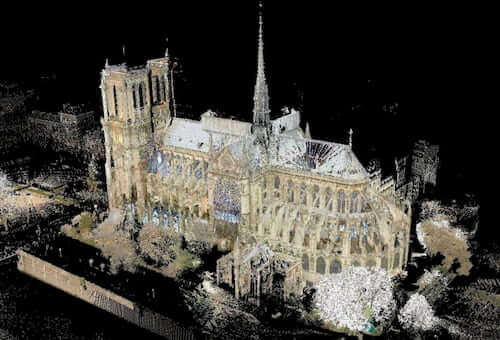
Overview of 3D scanning technologies
Photogrammetry
Photogrammetry consists of taking measurements from photographs to recover the exact positions of surface points.
The principle of photogrammetry is to analyze several photographs of a static subject, taken from different viewpoints, and to automatically detect pixels corresponding to the same physical point.
Photogrammetry enables scanners to capture an object’s color (a.k.a. texture). This technology also often serves to detect positioning markers (sticky targets placed on or around the object to help the scanner precisely align scans together).
Structured light
3D scanners using structured light project a series of linear light patterns onto an object.
The system is then able to examine the deformations of each line and to calculate the distance between the 3D scanner and the object’s surface. With this data, the software is able to build an accurate 3D model of the object.
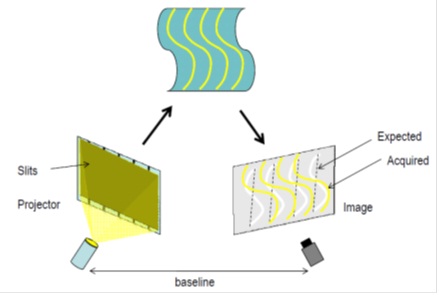
Triangulation
A 3D scanner using triangulation technology will project a laser beam on the object’s surface and measure the deformation of the laser ray (similar to structured light, but with one or more lasers).
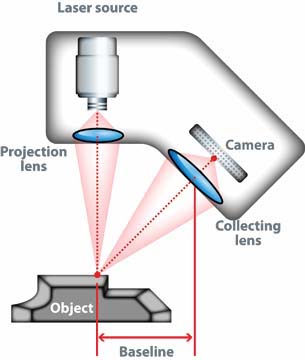
Contact
Contact 3D scanners probe the subject via physical touch. A touch probe moves along an object’s surface to record 3D information.
For more precise and detailed explanations, you can visit our 3D scanning technologies page.
FAQ
The most accurate 3D scanners are metrology 3D scanners, which generally offer an accuracy of around 20 microns.
This is entirely up to how much you will be using your 3D scanner. We can however say that 3D scanning is an impressive technology that does help save a lot of time for product design, reverse engineering, part inspection, and many other use cases.
Again, the definition of “good” is quite subjective in 3D scanning. Some of the best 3D scanners we have reviewed cost between $10,000 and $30,000. But a $5,000 3D scanner can do “good” if its specs meet your requirements.
Not only is 3D scanning hardware generally expensive, but so are the necessary, professional software solutions. Sometimes, it’s a one-time fee for a permanent license; other times, a monthly or yearly subscription is the only way to access a software suite. And to run such software, you will likely require a powerful, monster of a PC with a lot of RAM and a high-end graphics card. You may also need to buy a tripod or turntable if they aren’t included in your 3D scanner package. All of this can quickly amount to several thousand dollars.
Day-to-day 3D scanning expenses can include cans of mattifying spray and rolls of adhesive markers if you need them. Other than that, aside from potential software subscriptions, there are no extra hidden costs.
 English
English  Français
Français



